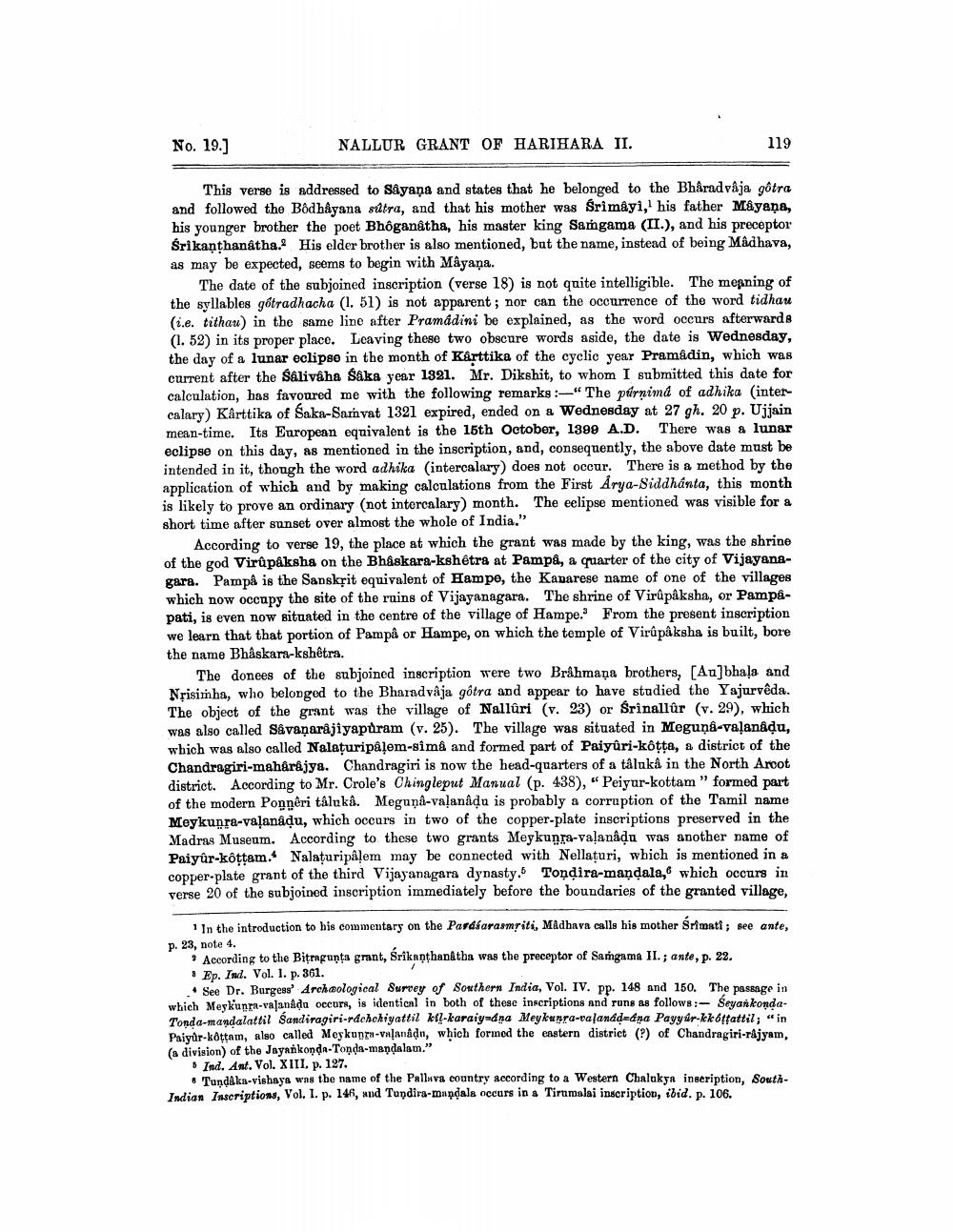________________
No. 19.]
NALLUR GRANT OF HARIHARA II.
119
This verse is addressed to Sayana and states that he belonged to the Bharad våja gôtra and followed the Bødhåyana sútra, and that his mother was Srimâyi, his father Måyana, his younger brother the poet Bhóganátha, his master king Samgama (II.), and his preceptor Śrikanthanatha. His elder brother is also mentioned, but the name, instead of being Madhava, as may be expected, seems to begin with Máyana.
The date of the subjoined inscription (verse 18) is not quite intelligible. The meaning of the syllables gâtradhacha (1. 51) is not apparent; nor can the occurrence of the word tidhar (i.e. tithau) in the same line after Pramadini be explained, as the word occurs afterwards (1. 52) in its proper place. Leaving these two obscure words aside, the date is Wednesday, the day of a lunar eclipse in the month of Kårttika of the cyclic year Pramådin, which was current after the Salivaha Saka year 1921. Mr. Dikshit, to whom I submitted this date for calculation, has favoured me with the following remarks :-" The púrnimd of adhika (intercalary) Kårttika of Saka-Samvat 1321 expired, ended on a Wednesday at 27 gh. 20 p. Ujjain mean-time. Its European equivalent is the 15th October, 1399 A.D. There was a lunar eclipse on this day, as mentioned in the inscription, and, consequently, the above date must be intended in it, though the word adhika (intercalary) does not occur. There is a method by the application of which and by making calculations from the First Arya-Siddhanta, this month is likely to prove an ordinary (not intercalary) month. The eclipse mentioned was visible for a short time after sunset over almost the whole of India."
According to verse 19, the place at which the grant was made by the king, was the shrine of the god Virûpåksha on the Bhaskara-kshetra at Pampå, a quarter of the city of Vijayanagara. Pampå is the Sanskrit equivalent of Hampe, the Kaparese name of one of the villages which now occupy the site of the ruins of Vijayanagara. The shrine of Virûpaksha, or Pampepati, is even now situated in the centre of the village of Hampe. From the present inscription we learn that that portion of Pampå or Hampe, on which the temple of Virupaksha is built, bore the name Bhaskara-kshetra.
The donees of the subjoined inscription were two Brâhmaņa brothers, [Au]bhala and Nrisimha, who belonged to the Bharadvaja gôtra and appear to have studied the Yajurveda. The object of the grant was the village of Nallûri (v. 23) or Srinallûr (v. 29), which was also called Savanaråjiyapuram (v. 25). The village was situated in Meguna-vaļanadu, which was also called Nalaturipalem-simå and formed part of Paiyûri-kõtta, a district of the Chandragiri-maharajya. Chandragiri is now the head-quarters of a tåluka in the North Aroot district. According to Mr. Crole's Chingleput Manual (p. 438), "Peiyur-kottam " formed part of the modern Ponneri tâlukâ. Meguņa-valanâdu is probably a corruption of the Tamil name Meykunra-vaļanadu, which occurs in two of the copper-plate inscriptions preserved in the Madras Museum. According to these two grants Megkunra-valanadu was another name of Paiyûr-kottam. Nalaturipalem may be connected with Nellaturi, which is mentioned in a copper-plate grant of the third Vijayanagara dynasty. Tondira-mandala, which occurs in verse 20 of the subjoined inscription immediately before the boundaries of the granted village,
In the introduction to his commentary on the Parásarasmriti, Madhava calls his mother Srimati; see ante, p. 23, note 4.
According to the Bitrgunta grant, Srikanthanatha was the preceptor of Samgama II.; ante, p. 22. • Ep. Ind. Vol. 1. p. 361.
See Dr. Burgeos' Arohaological Survey of Southern India, Vol. IV. pp. 148 and 150. The passage in which Merkura valanada occurs, is identical in both of these inscriptions and runs as follows:- Seyan konda. Tonda-mandalattil Sandiragiri-rdchchiyattil kil-karaiyadna Meykura valanddedya Payyar.kk6tfattil; "in Paiyûr-kottam, also called Megkunta-valandn, which formed the eastern district (?) of Chandragiri-rajyam, (a division) of the Jaya konda-Tonda-mandalam."
Ind. Ant. Vol. XIII. p. 127.
TundAka-vishaya was the name of the Palliva country according to a Western Chalukya inscription, SouthIndian Inscriptions, Vol. 1. p. 146, sud Tundira-mandala accurs in a Tirumalai inscription, ibid. p. 106.




